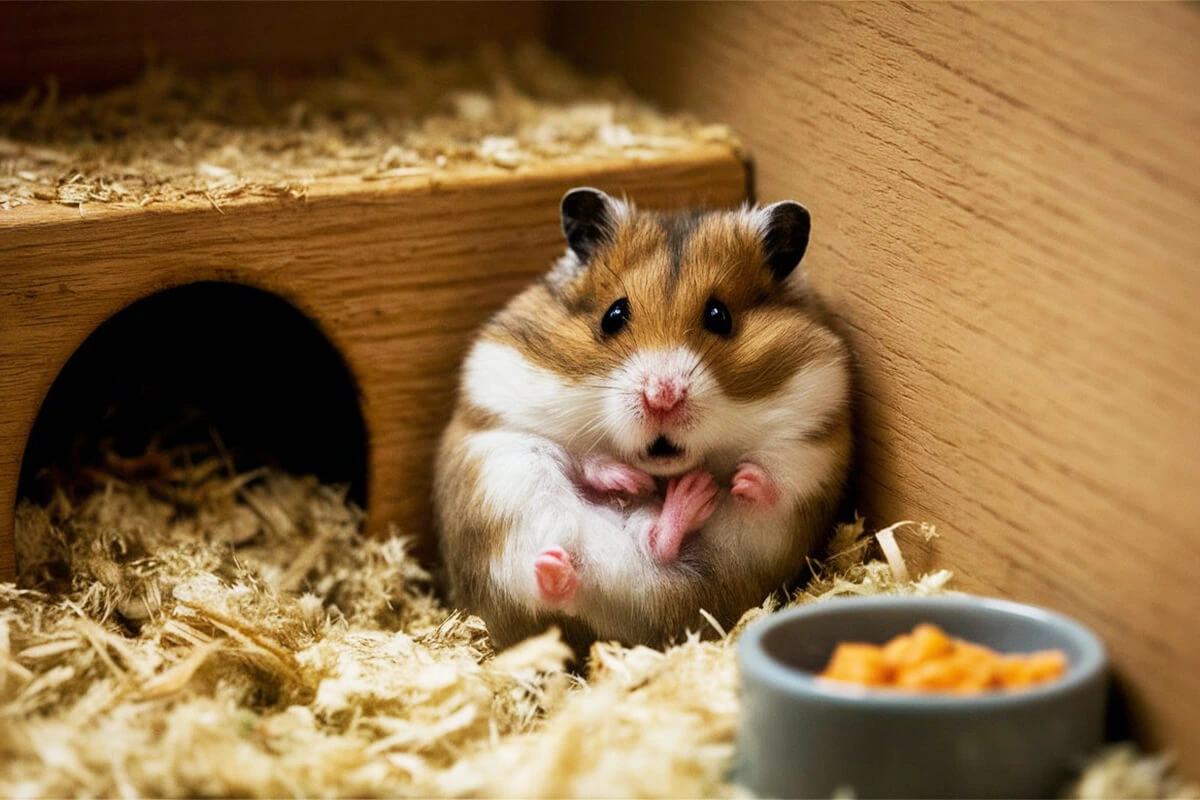A scared hamster can show many signs of fear, from freezing in place to biting when handled. Hamsters may be small, but they have big emotions and get frightened easily. Because they are prey animals in the wild, loud noises, sudden movements, or unfamiliar surroundings can make them feel threatened. If they don’t feel safe, their body language and behavior will change quickly.
Recognizing these signs early can help prevent serious stress-related health problems. A frightened hamster may hide, refuse to eat, or even become aggressive when it feels cornered. Understanding these warning signals allows you to respond appropriately and create a calm, secure environment.
In this guide, you’ll learn the top 10 signs of a scared hamster and how to calm it down quickly. Whether you just brought home a new pet or your hamster suddenly seems anxious, these tips will help you build trust and ensure your furry friend feels safe.
10 Signs Your Hamster Is Scared
1. Hiding More Than Usual (Using Bedding or Hideout Excessively)
A scared hamster often hides for long periods, using its bedding or hideout as a shield from what it perceives as danger. While hamsters naturally enjoy burrowing and sleeping in enclosed spaces, excessive hiding can signal fear. If your hamster refuses to come out for food, play, or interaction, it may feel unsafe in its environment. Check for potential stressors like loud noises, sudden movements, or new pets in the room.
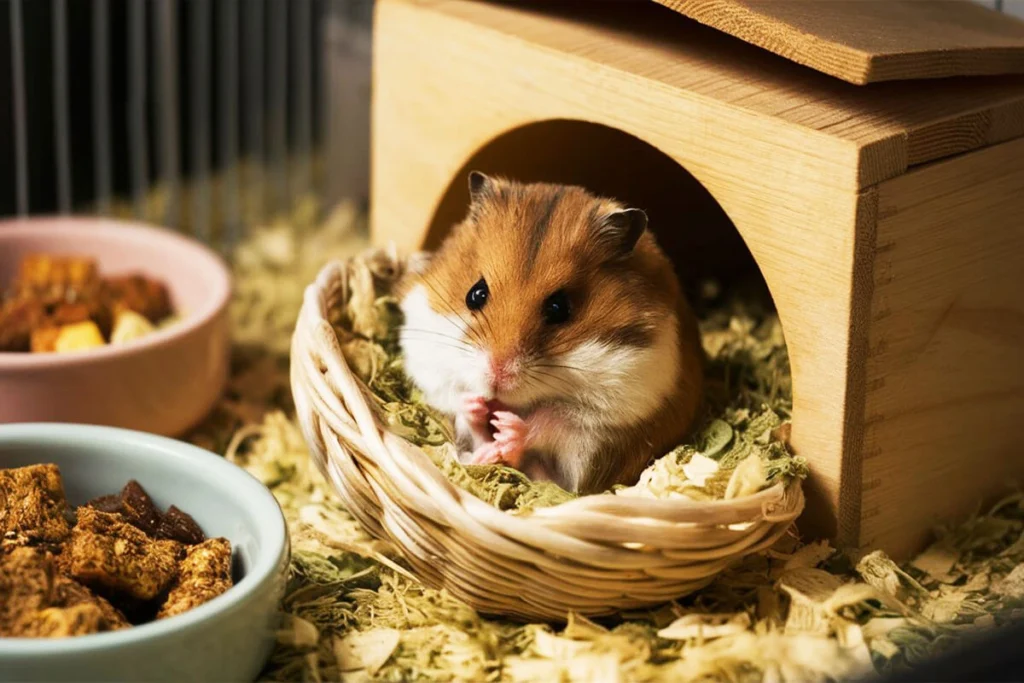
2. Freezing in Place (Staying Motionless to Avoid Detection)
When a hamster freezes in place, it tries to avoid detection by a perceived threat. This instinct comes from their wild survival behavior, where staying still helps them blend into their surroundings and escape predators. If your hamster suddenly stops moving and remains completely still, it likely feels scared. Avoid sudden hand movements or loud noises, and give it time to feel secure before attempting interaction.
3. Excessive Squeaking (Indicating Distress or Fear)
Hamsters use squeaking as a form of vocal communication. A happy hamster may squeak softly, but frequent or loud squeaking often signals distress, fear, or discomfort. If your hamster squeaks when you approach, handle it, or when another pet is nearby, it may feel threatened. Pay attention to when and why the squeaking happens to identify and remove the source of stress.
4. Biting or Aggression (Defensive Behavior When Handled)
A scared hamster may bite, lunge, or show aggressive behavior when someone tries to handle it. This reaction comes from fear, not malice. If a hamster feels trapped or overwhelmed, it defends itself by biting. Sudden, forced handling, an unfamiliar scent on your hands, or a stressful environment can all trigger aggression. Always let your hamster get comfortable before attempting to pick it up. Use slow, gentle movements to build trust.
5. Sudden, Fast Movements (Jerky, Skittish Behavior)
A nervous hamster often moves in quick, erratic motions. It may dart around the cage, jump unexpectedly, or flinch when you get close. These sudden movements indicate fear and high alertness. If your hamster constantly acts skittish, check its surroundings for potential stressors like bright lights, loud sounds, or unfamiliar objects. Providing a calm, predictable environment can help reduce this behavior.
6. Excessive Burrowing (Seeking Safety in Bedding)
Hamsters naturally burrow in bedding, but a frightened hamster may dig excessively, almost as if trying to escape or hide completely. It might spend most of its time tunneling deep into its bedding, avoiding contact and interaction. If this behavior happens often, your hamster might feel unsafe. Ensure it has a cozy, quiet place to rest, and minimize environmental stressors to help it feel more secure.
7. Loss of Appetite (Ignoring Food & Treats)
A scared hamster may refuse to eat, even when offered its favorite food or treats. Stress and fear can suppress appetite, making a hamster hesitant to come out and eat. If your hamster suddenly stops eating, check for signs of anxiety, illness, or discomfort. Make sure the cage setup feels secure, and give your hamster time to adjust if it’s in a new environment. If appetite loss persists, consult a vet to rule out health issues.
8. Over-Grooming or Fur Loss (Signs of Hamster Anxiety Symptoms)
If a pet is grooming itself too much, it might mean that it feels stressed or anxious. A frightened hamster may obsessively groom itself, leading to bald patches or irritated skin. This behavior often occurs when a hamster feels anxious, overwhelmed, or lacks enough enrichment in its cage. Make sure your hamster has enough space, toys, and hiding spots to feel comfortable. If fur loss continues, consult a vet to check for underlying health issues.
9. Nocturnal Restlessness (More Active Than Usual at Night)
Hamsters are nocturnal, meaning they naturally stay active at night. However, excessive nighttime activity—such as running on the wheel for hours without breaks, chewing cage bars, or frantically exploring—can indicate stress. A hamster that seems overly restless might feel unsafe in its environment. Ensure its cage setup provides enough comfort, hideouts, and stress relief toys to reduce anxiety.
10. Trembling or Shaking (Physical Sign of Fear and Nervousness)
Trembling or shaking often happens when a hamster feels extremely scared. You might notice it shaking slightly after being startled or when introduced to a new environment. This reaction can also occur if a hamster feels cold, so check the cage temperature to ensure it’s warm enough. If your hamster trembles frequently, create a calm, predictable routine and allow it to settle in at its own pace.
By recognizing these signs of a scared hamster, you can take the right steps to help it feel safe, secure, and comfortable in its home.
Why Your Hamster Might Be Scared
New Environment Can Make Hamsters Scared
A hamster feels anxious when it moves into a new environment. Whether you just brought it home from the pet store or changed its cage setup, unfamiliar surroundings can overwhelm it. The new scents, sights, and sounds take time to process, making the hamster feel vulnerable. It may hide more, refuse to eat, or avoid interaction while it adjusts. To help it feel safe, give it a few days without disturbances. Avoid handling it too soon and let it explore its new space at its own pace. Providing familiar items, such as bedding from its previous home, can also ease the transition.
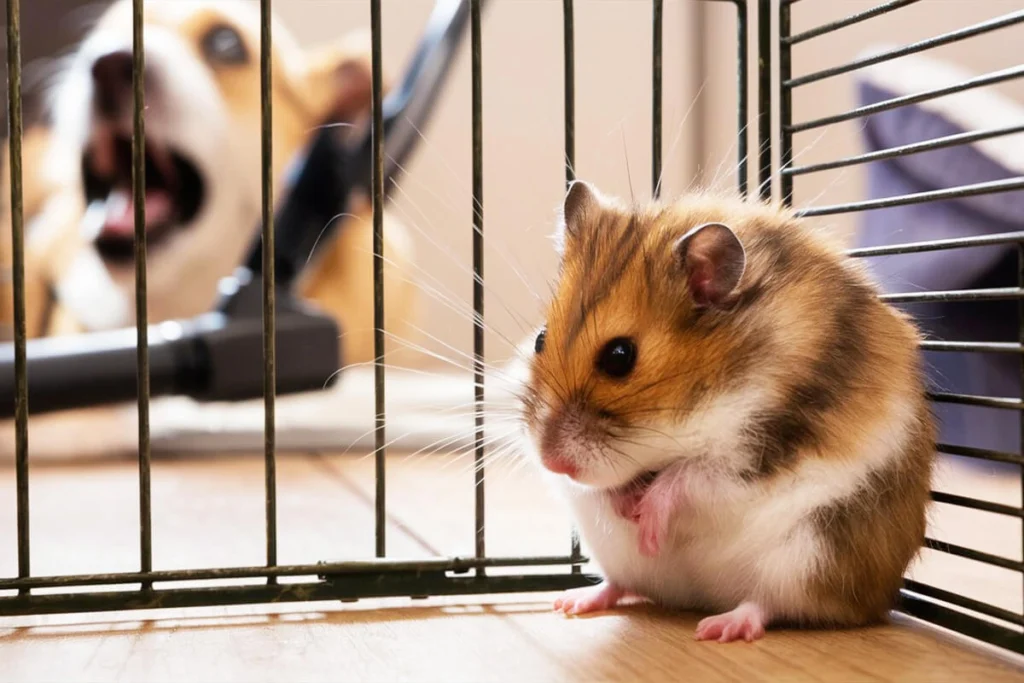
Loud Noises & Sudden Movements
Hamsters startle easily because they rely on their sharp hearing to detect danger. Loud noises, such as televisions, vacuum cleaners, barking dogs, or slamming doors, can make a hamster feel unsafe. Sudden movements, like a hand reaching into the cage too quickly, may trigger a fear response. If your hamster reacts by freezing, running away, or hiding, it likely feels scared by these disturbances. Keep its cage in a quiet, low-traffic area and approach it gently to prevent stress. Speaking softly and avoiding quick gestures will also help build trust.
Improper Handling
Handling a hamster incorrectly can cause fear and stress. If you grab it suddenly, lift it too high, or squeeze it too tightly, it may feel threatened and react by biting or struggling. Even if you mean no harm, rough or unexpected handling makes a hamster defensive. New hamsters, in particular, need time to adjust before they feel comfortable being held. Instead of forcing interaction, allow the hamster to come to you. Offer treats from your hand, let it sniff you, and gradually introduce handling in short, positive sessions.
Lack of Hideouts or Safe Spaces
Hamsters need secure places to retreat when they feel scared. Without proper hideouts, tunnels, or nesting areas, they become stressed and anxious. If a hamster has no safe space, it will feel constantly exposed, making it more likely to hide in bedding or avoid exploring its cage. Provide at least one or two enclosed hideouts, such as a small wooden house or tunnel. Deep bedding also allows natural burrowing behavior, which helps a hamster feel more secure. The more hiding options it has, the more confident and relaxed it will feel in its environment.
By identifying and removing these common stressors, you can create a safe, calm space where your hamster feels comfortable and at ease.
How to Calm a Scared Hamster Fast
Give It Time & Space
A scared hamster needs time to adjust before it feels comfortable in its surroundings. If you recently brought it home or changed its cage setup, give it a few days to explore without interference. Avoid handling or disturbing it too soon, as forced interaction can increase its stress. Let it come out of hiding on its own and observe its new environment at its own pace. Place food and treats near its hideout to encourage trust without pressure. The more patience you show, the more your hamster will start to feel safe.
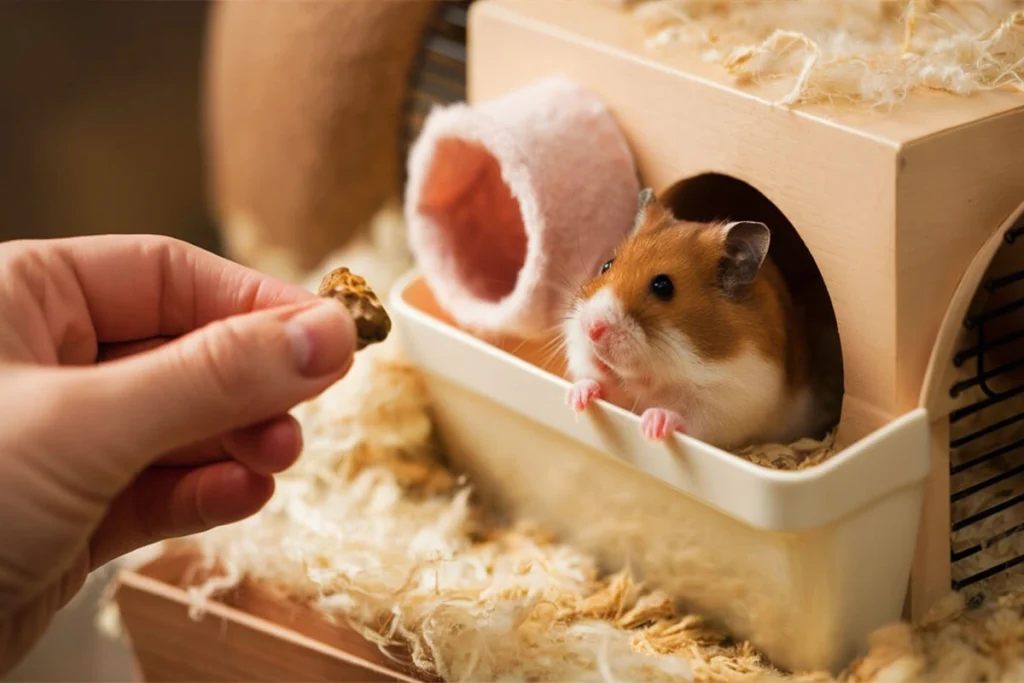
Create a Safe Habitat For your Scared Hamster
A secure and comfortable habitat helps reduce stress and fear in hamsters. Ensure the cage includes essential items like a cozy hideout, deep bedding for burrowing, and tunnels for exploration. Keep the cage in a quiet area, away from loud noises, bright lights, or frequent foot traffic. Provide a running wheel and chew toys to help relieve anxiety through natural activities. If your hamster feels safe in its environment, it will explore more, hide less, and show fewer signs of fear.
Use Gentle Handling Techniques
Handling a nervous hamster requires slow and careful movements. Never grab or chase it around the cage, as this will only make it more afraid. Instead, let it approach you by placing your hand inside the cage with a treat. Allow it to sniff and climb onto your hand on its own. Start with short handling sessions, keeping your hands close to a soft surface in case it jumps away. Support its body properly and avoid sudden movements. With consistent, gentle handling, your hamster will learn to trust you and feel more relaxed.
Talk Softly & Move Slowly
Your hamster responds to the way you interact with it. Loud voices or fast hand movements can scare it, making trust-building difficult. Speak to your hamster in a soft, calm tone so it gets used to your voice. When approaching the cage, move slowly and avoid sudden gestures. Let it see your hand before reaching inside to prevent startling it. If your hamster associates your presence with gentle movements and soothing sounds, it will feel more comfortable and less anxious over time.
By following these steps, you can help your hamster feel safe, build trust, and reduce its fear effectively.
Best Stress Relief Toys & Comfort Items
Hideouts & Tunnels
Hamsters feel safest when they have enclosed spaces to retreat to. Hideouts and tunnels provide the security they need when they feel scared or overwhelmed. A well-placed hideout gives a hamster a private space to sleep, rest, and escape from stressful situations. Wooden or plastic hideouts mimic burrows found in the wild, helping hamsters feel protected. Tunnels create an enriching environment by allowing them to explore, navigate, and hide when necessary. Placing multiple hideouts and tunnels in different areas of the cage encourages natural behavior and reduces stress. If a hamster has a safe space to run to, it will feel more confident and relaxed in its environment.
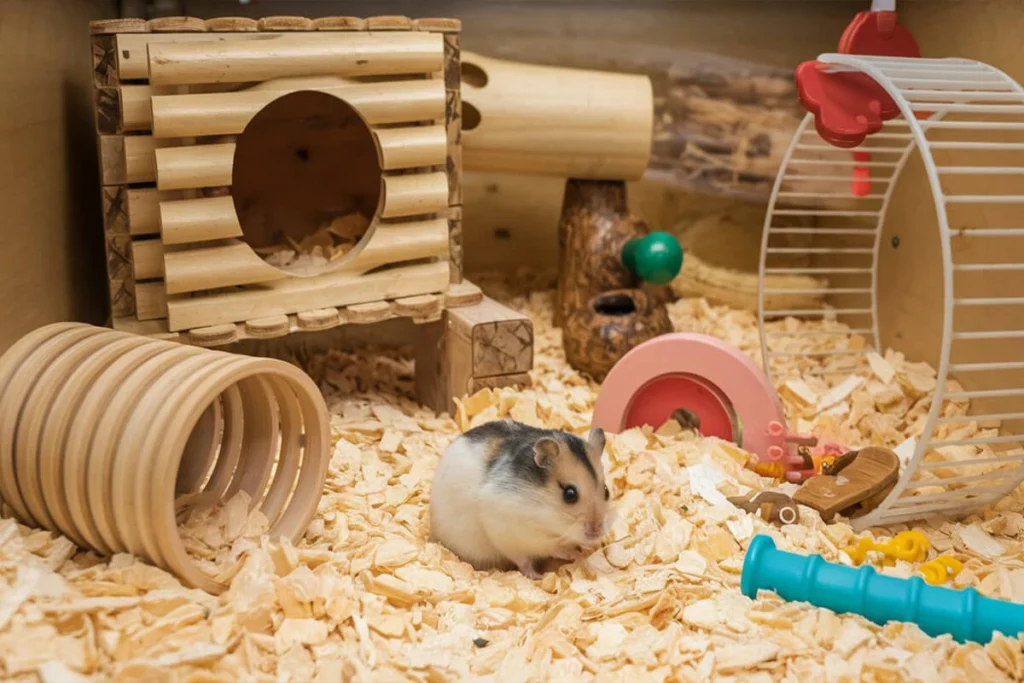
Running Wheel
Physical activity plays a huge role in reducing stress and anxiety in hamsters. A running wheel provides an essential outlet for pent-up energy, preventing boredom and nervousness. Hamsters instinctively run long distances in the wild, and without this opportunity, they may develop anxiety-related behaviors such as cage biting or excessive grooming. A quiet, appropriately sized wheel allows them to exercise without causing harm to their backs. If a hamster runs frequently on its wheel, it is using a natural stress-relief method to stay calm and balanced. Keeping a reliable wheel inside the cage ensures a hamster stays active, mentally stimulated, and emotionally stable.
Chew Toys & Food Treats
Chewing helps a hamster relieve stress while keeping its teeth healthy. Wooden chew toys, mineral blocks, or natural gnaws like apple sticks provide a safe and satisfying way to ease tension. When a hamster feels nervous, chewing gives it something productive to focus on, helping to redirect anxious energy. Food treats also work as a calming tool, especially when used to build trust. Offering a favorite snack, such as a sunflower seed or a small piece of fruit, encourages positive associations with human interaction. If a hamster learns that your presence means good things, it will become more comfortable and less fearful over time.
Soft Bedding & Nesting Material
A cozy sleeping area helps a hamster feel secure and reduces overall stress. Soft bedding allows for burrowing, which is a natural way for hamsters to self-soothe and feel protected. Materials like paper-based bedding, aspen shavings, or shredded tissue create a warm and comfortable nesting space. Nesting material, such as soft hay or tissue paper, gives a hamster the ability to build its own sleeping area, providing an added sense of security. When a hamster has the right bedding setup, it sleeps better, hides less, and feels safer in its cage. A well-prepared sleeping area plays a major role in reducing fear and promoting relaxation.
By adding these essential stress-relief items to the cage, a hamster will feel more comfortable, secure, and confident in its home.
When to Seek Help from a Vet For your Scared Hamster
Persistent Signs of Stress
A hamster that stays anxious for a long time needs extra attention. Occasional nervous behavior is normal, especially in new environments, but constant fear can affect its health. If a hamster hides excessively, freezes often, or refuses to explore even after weeks in a stable environment, something might be wrong. Loud noises, improper handling, or a stressful cage setup could be causing ongoing fear. Identifying and removing the source of stress is important, but if the hamster still shows signs of extreme anxiety, consulting a veterinarian or an experienced hamster expert can help rule out underlying health issues.
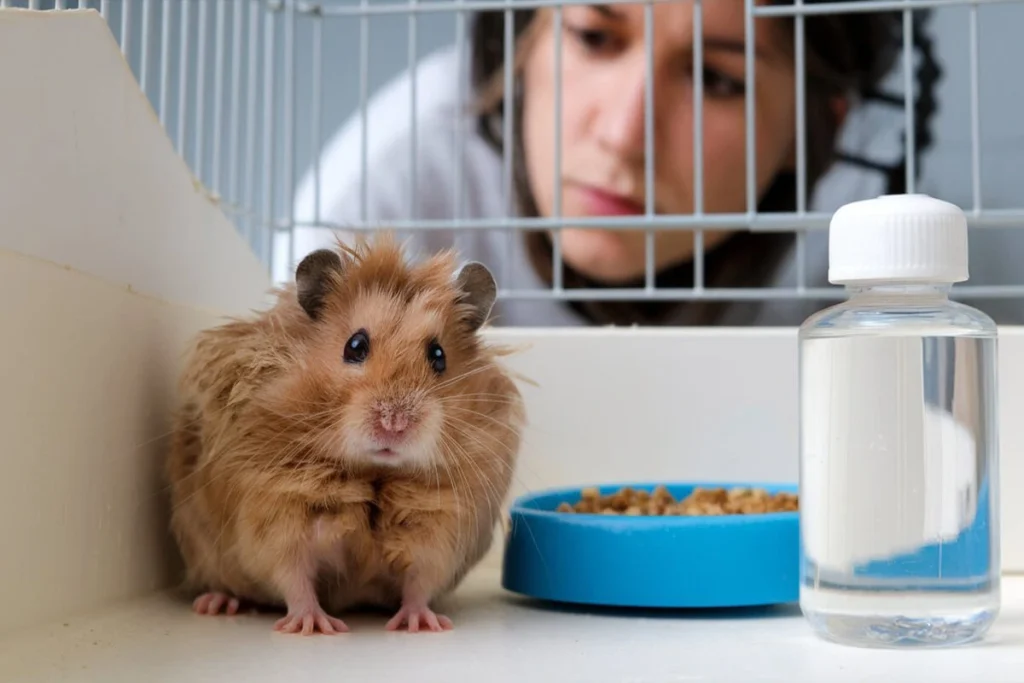
Refusal to Eat or Drink
Hamsters love to eat, so a sudden loss of appetite signals a problem. A scared hamster may refuse food temporarily, especially after a big change, but consistent avoidance of food or water can lead to serious health risks. If a hamster ignores fresh treats, avoids its food dish, or drinks significantly less water than usual, stress may not be the only issue. Dehydration and malnutrition can develop quickly in small animals, so it’s important to act fast. Checking for signs of illness, dental problems, or discomfort can help determine whether stress or a medical condition is the cause. If the hamster continues refusing food and water for more than 24 hours, a veterinarian should examine it as soon as possible.
Unusual Lethargy or Aggression
A drastic change in energy levels often indicates a deeper issue. If a normally active hamster becomes sluggish, uninterested in playing, or spends most of the time curled up in a corner, it might feel unwell or extremely stressed. On the other hand, a hamster that suddenly becomes aggressive, bites more frequently, or reacts defensively to every interaction may feel unsafe or be experiencing pain. Monitoring its behavior closely helps determine whether the change is temporary or a sign of a more serious problem. If the hamster remains unusually inactive or aggressive despite a calm and comfortable environment, a veterinarian can check for hidden health concerns.
Skin Problems from Over-Grooming
Grooming is a natural behavior, but excessive licking, scratching, or fur loss suggests something is wrong. A stressed hamster may groom itself too much as a way to cope with anxiety, leading to bald patches or irritated skin. Over-grooming can also result from mites, allergies, or other skin conditions, so it’s important to check for redness, flaky skin, or signs of discomfort. Providing enough bedding, chew toys, and mental stimulation can help reduce stress-related grooming, but if fur loss continues or the skin looks inflamed, a veterinarian should assess the hamster’s condition.
Recognizing these warning signs early can prevent serious health issues. If stress-related behaviors persist or worsen, professional help ensures the hamster gets the care it needs to feel safe and healthy again.
Conclusion
Helping a scared hamster feel safe takes time, patience, and a good understanding of its behavior. Fearful hamsters often show clear signs of distress, such as excessive hiding, freezing in place, or sudden bursts of skittish movement. By paying close attention to these signals, you can take the right steps to comfort and reassure your pet.
Creating a secure and quiet environment makes a huge difference in reducing fear. Providing hideouts, tunnels, soft bedding, and a proper cage setup helps a hamster feel protected. Avoiding loud noises, sudden movements, and improper handling also prevents unnecessary stress. Offering treats, speaking softly, and using slow, gentle interactions build trust over time, allowing the hamster to see you as a source of safety rather than a threat.
If a hamster continues to show signs of extreme stress despite a calm and stable environment, checking for potential health issues becomes important. A refusal to eat, excessive aggression, or noticeable fur loss could indicate a deeper problem that needs professional attention. A veterinarian can help determine if an underlying health issue is causing the behavior.
By understanding what makes a hamster feel scared and how to ease its anxiety, you can create a safe, happy home where it feels comfortable and secure. With patience, consistency, and proper care, even the most nervous hamster can learn to trust and enjoy life in its new home.
Pick The Best Name For your Lovely Hamster from our Top 100 Names HERE!
Read More about Furry Pets From HERE!
Find Out the Best stuff for your Pet On Pet MD Official
